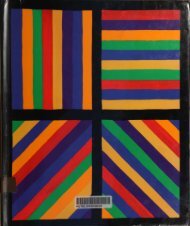SITUATIONISTS AND THE 1£CH MAY 1968
umMYFs
umMYFs
Create successful ePaper yourself
Turn your PDF publications into a flip-book with our unique Google optimized e-Paper software.
down and two were seriously injured. Many<br />
more narrowly escaped. The van was finally surrounded.<br />
One. of the policemen in the front seat<br />
. was dragged out and repeatedly punched by the<br />
infuriated crowd, determined to lynch him. He<br />
was finally rescued, in the nick of time, by the<br />
stewards. They more or less carried him, semiconsciqus,<br />
down a side street where he was<br />
passed horizontally, like. a battered blood<br />
sausage, through an open ground floor window.<br />
To do this, the stewards had had to engage<br />
in a running fight with several hundred very<br />
angry marchers. The crowd then started rocking<br />
the stranded police van. The remaining policeman<br />
drew his revolver and fired. People ducked.<br />
By a .miracle no-one was hit. A hundred yards<br />
away the bullet made a hole, about three feet<br />
above ground level, in a window of'le Belfort', a<br />
big can at 297 Boulevard Raspail. The stewards<br />
again rushed to the rescue, forming a barrier<br />
between the crowd and the police . van, which<br />
was allowed to escape down a side street, driven<br />
by the policeman who had fired at the crowd.<br />
Hundreds of demonstrators then thronged<br />
round the hole in the window of the cafe. Press<br />
photographers were summoned, arrived, duly<br />
took their close-ups - none of which, of course,<br />
were ever published. (Two days later I' Humanite<br />
carried a few lines about the episode, at the bottom<br />
of a column on page s.) One effect of the<br />
episode is that several thousand more demon<br />
. strators decided not to disperse. They turned<br />
and marched down towards the Champ de Mars,<br />
shouting "lls ont tire a Oenfert" (they've shot at<br />
us at Oenfert). If the incident had taken place an<br />
hour earlier, the evening of 13 May might have<br />
had a very different complexion.<br />
The Sorbonne 'Soviet'<br />
On Saturday 11 May, shortly before midnight, Mr<br />
Pompidou, Prime Minister of France, overruled<br />
his Minister of the Interior, his Minister of<br />
Education, and issued orders to his 'independent'<br />
Judiciary. He ·announced that the police<br />
would be withdrawn from the Latin Quarter, that<br />
the faculties would re-open on Monday 13 May,<br />
and that the law would 'reconsider' the question<br />
of the students arrested the previous week. lt<br />
was the biggest political climb-down of his<br />
career. For the students, and for many others, it<br />
was the llving proof that direct action worked.<br />
Concessions had been won through struggle<br />
which had been unobtainable by other means.<br />
Early on the Monday morning the CRS platoons<br />
guarding the entrance to the Sorbonne<br />
were discreetly withdrawn. The students moved<br />
in, first in small groups, then in hundreds, later<br />
in thousands. By midday the occupation. was<br />
complete. Every 'tricolore' was promptly hauled<br />
down, every lecture theatre occupied. Red flags<br />
were hoisted from the official flagpoles and from<br />
improvised ones at many windows, some overlooking<br />
the streets, others the big internal courtyard.<br />
Hundreds of feet above the milling stu·<br />
dents, enormous red and black flags fluttered<br />
side by side from the Chapel dome.<br />
What happened over the next few days will<br />
leave a permanent mark on the French educational<br />
system, on the structure of French society<br />
and • most important of aH • on the minds of<br />
those who lived and made history during that<br />
hectic first fortnight. The Sorbonne was suddenly<br />
transformed from the fusty precinct where<br />
French capitalism selected and moulded its hierc<br />
archs, its technocrats and its administrative<br />
bureaucracy into a revolutionary volcano in full<br />
eruption whose lava was to spread far and wide,<br />
searing the social structure of modern France.<br />
The physical occupation of the Sorbonne<br />
was followed by an intellectual explosion of<br />
unprecedented violence. Everything, literally<br />
everything, was suddenly and simultaneously ·<br />
up for discussion, for question, for challenge.<br />
There were no taboos. lt is easy to criticise the<br />
chaotic upsurge of thoughts, ideas and proposals<br />
unleashed in . such c.ircumstances.<br />
'Professional revolutionaries' and petty bourgeois<br />
philistines criticised to their heart's content.<br />
Butin so doing they only revealed ow they<br />
themselves were trapped in the ideolpgy of a<br />
previous epoch and were incapable of tran·<br />
scending it. They failed to recognise the tremendous<br />
significance of the new, of all that could<br />
not be apprehended within their own pre-established<br />
intellectual categories. The phenomenon<br />
was witnessed again and agailil, as it doubtless<br />
has been in every really great upheaval in history.<br />
Day and night, every lecture theatre was










